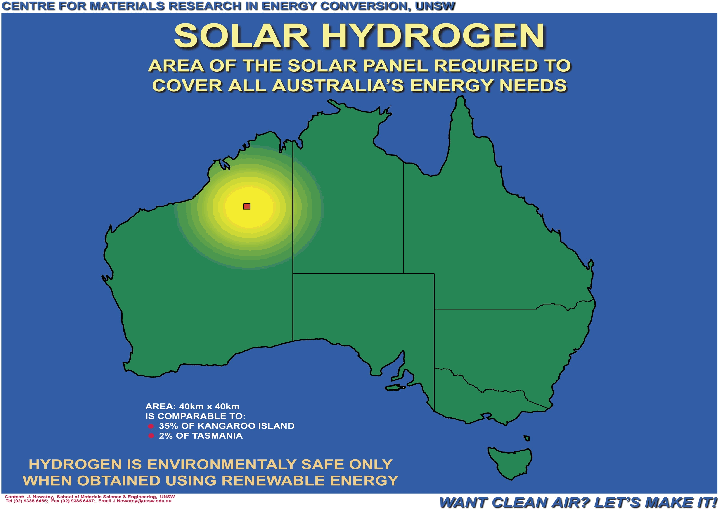|
News & Views item - August 2004 |
![]() "Mother,
Give Me the Sun," is Oswald's Dieing Plea to his Mother in Ibsen's Ghosts.
(August 30 ,2004)
"Mother,
Give Me the Sun," is Oswald's Dieing Plea to his Mother in Ibsen's Ghosts.
(August 30 ,2004)
Oswald paying for the sins of his father is succumbing to the madness engendered by tertiary syphilis but now 122 years since it's premier performance, Oswald's plea may be just beginning to be fulfilled. But it'll take time, investment and political will. On Friday August 27 the University of New South Wales hosted a one-day conference the 2004 International Conference on Materials for Hydrogen Energy which dealt with advances in materials for converting solar energy into hydrogen and eliminating the "middleman" of fossil fuels the current primary source for hydrogen production.

Despite the Federal Government's recent strong endorsement for a future energy policy strongly supportive of fossil fuel production and usage, the conference was opened by the Minister for Science Peter McGauran who told the conference that Australia is playing a leading role in international hydrogen research.
"Australian research contributes significantly to developments in hydrogen energy technology including work by the Centre for Materials Research in Energy Conversion and the University of Tasmaniaís dedicated hydrogen research lab that is looking at converting Australia Postís fleet of motorcycles to using hydrogen." Mr. McGauran continued, "Australiaís research into hydrogen energy will make a valuable contribution to the Governmentís strategy for reducing Australia's greenhouse gas emissions while still providing reliable and efficient energy."
However on July 15 the
Prime Minister, John Howard, in presenting the
Coalition Government's forthcoming eight year energy policy![]() noted that the Mandatory Renewable Energy Target (MRET) scheme
would remain unchanged (MRET currently requires that 2% of electricity be
generated from renewable sources.) thereby giving no additional incentive
to raise the bar. Mr Howard went on to make the sweeping statement to the
National Press Club:
noted that the Mandatory Renewable Energy Target (MRET) scheme
would remain unchanged (MRET currently requires that 2% of electricity be
generated from renewable sources.) thereby giving no additional incentive
to raise the bar. Mr Howard went on to make the sweeping statement to the
National Press Club:
Expanding MRET would impose substantial new costs on the economy and would benefit too few technologies. A better path is to directly promote the development and demonstration of a broader range of low emission technologies and tackle the impediments to the uptake of renewable energy.
In short, stuff solar, wind and tidal power.
One of the most interesting set of papers recently published is in the August 13, 2004 issue of Science, grouped under the heading "Toward a Hydrogen Economy" because it gives a balanced hard headed assessment of what is and will be involved in evolving toward a hydrogen economy. Robert Coontz and Brooks Hanson introduce the topic in "Not so Simple" and point out "at normal human-scale temperatures, [hydrogen] is an invisible gas: light, jittery, and slippery; hard to store, transport, liquefy, and handle safely; and capable of releasing only as much energy as human beings first pump into it. All of which indicates that using hydrogen as a common currency for an energy economy will be far from simple."
That said Iceland, population 300,000, currently is one of the trail blazers in moving to a hydrogen economy based wholly on geothermal and renewable resources. Currently they use no fossil fuels in electricity production, hydroelectric power furnishing 82.5% and geothermal power 17.5%. However, as Gretchen Vogel reports, "With geothermal and hydroelectric sources supplying almost all of its heat and electricity, Iceland is well on the way to energy self-sufficiency. Now it is betting that hydrogen-fueled transportation will supply the last big piece of the puzzle. ... By 2050, they say, Iceland should run on a completely hydrogen-based energy economy. The hydrogen-powered fuel cell buses--three ply the route [around Reykjavik] regularly--are the first step toward weaning Iceland off imported fossil fuels, says Thorsteinn Sigfusson, a physicist at the University of Iceland in Reykjavik and founding chair of Icelandic New Energy, a company launched to test and develop hydrogen-based transport and energy systems."
But Iceland still imports 30% of its energy as oil to power cars and the ships of its fishing fleet. Converting those vehicles to hydrogen fuel is the aim in order to make the nation fully self sufficient and producing minimum pollution from energy utilization. But it's not a given. Reykjavik's lone hydrogen station, which manufactures the fuel on site by splitting water molecules, can fill a bus with pressurized gas in 6 minutes. Fine for three buses but scaling up will take ingenuity and effort.
Fri_rik Sophusson, a former finance minister and now managing director of the government-owned National Power Co., a shareholder in Icelandic New Energy told Vogel that he believes the investment will pay long-term dividends, "In 20 years, I believe we will have vehicles running on hydrogen efficiently generated from renewable sources; we are going to produce hydrogen in a clean way, and if the project takes off, we will be in business." However, Vogel points out that "the biggest hurdle will be the conversion of its economically vital shipping, which uses half of the country's imported oil. Boats pose tougher technical problems than city buses do. Whereas a bus can run its daily route on only 40 kilograms of hydrogen, Sigfusson says, a small trawler with a 500-kilowatt engine must carry a ton of the gas to spend 4 to 5 days at sea."
But they're working on it.
From Australia's viewpoint the production of sufficient electrical power for hydrogen to be produced through electrolysis based on solar, wind, geothermal and tidal power has minimal governmental support while the development of the technologies for the storage and transportation of hydrogen for use either in H2 based internal combustion engines or fuel cells to power electric motors seems decades behind the efforts being undertaken in Iceland.